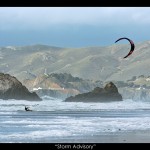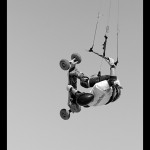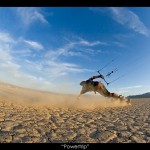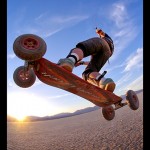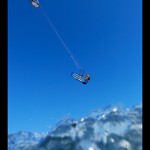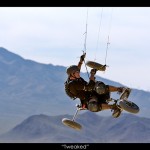A couple of years ago Steve Hall of GWTW and I were yakking about kite photography, including words about some of the better practitioners of the art. We’d kicked around such august luminaries as John Chilese and Dan Whitney, when Steve mentioned that GWTW’s webmaster was another one that really should be considered. Well, I’d never heard of Rob Vreeland before, so Steve brought up Rob’s web site, and I really had my eyes opened…
Now, a year or so later, I’m here with Kitelife, and John and I were kicking around the concept of the “Visual Excitement” inherent in good photographs in Kitelife – what they do for the site, how readers respond, and so forth… And, within a day of that conversation, I also happened on a GWTW Forum thread concerning Rob Vreeland’s publishing in all the Power Kite-pubs, and wanting some more exposure…
Well, I may be getting old and a bit slow, but I’m not daft.. Kitelife contacted Rob and he’s agreed to a photo gallery and an interview. Herewith, the results of our combined labors, starting with the interview. Enjoy!
So Rob. There are thousands of kiters out there who have seen your photography in the pages of magazines or online. They are some of the most amazing images I’ve run across. How did get into photography?
Dave, thanks for giving me this opportunity to more formally introduce myself to the kiting community.
It’s kind of cool how I got I got interested in photography. About twenty years ago my Dad purchased a sweet, Nikon FG camera. Being a total gadget, gizmo kind of kid, I was mesmerized by all of its dials, levers and buttons. I wanted nothing more than to play with it but it was off limits to my fingers. My Dad was right in thinking I would have broken it. Skip forward five or so years and I start going to a new high school that offered an excellent photography program. I decide to give it a try in hopes that I would learn to use a camera so I could finally play with the beautiful Nikon my Dad had collecting dust in his closet. By the end of my junior year I had scored early acceptance to Rochester Institute of Technology, one of the top photography schools in the world. By my senior year I had logged more hours in the darkroom than any other student at my high school. From there the deal was sealed. Photography became a part of my life that will never go away. Fast forward to today and that Nikon FG is sitting here on my desk as a paperweight. Worst part is, it was broken by the time I ever got to use it. It sat on my Dad’s shelf so long, the dust sealed the shutter.
Interesting… You went to RIT, the “Eastman Kodak” school, and I was accepted at Brooks but never actually attended (long story). I’m assuming all that was quite some time ago. What kind of photo work have you been doing since you graduated from Rochester?
I actually never graduated from RIT. I started in 1992, majoring in commercial photography but switched majors at the end of my sophomore year. I ended up leaving RIT at the beginning of my senior year to work full time at a small computer company in Southern California (the same company I did my mandatory RIT internship with).
Since RIT I have done all sorts of photography hear and there. Weddings, portraits, commercial product shots, interior design portfolios, you name it. Just recently I was contracted by an art gallery to photograph and reproduce original Louise Dahl-Wolfe prints to be displayed in the windows of Neiman Marcus. I also really like to take pictures of my dog, Murphy.
Now, I know a little bit about RIT, and as I remember, much of the curriculum centered on film-based still photography or cinematography. Either way, most of it was film-based as I remember. Did you continue to shoot film for some time, and when did you switch to digital – or do you still shoot both now?
At RIT all I shot was film. Everything from pinhole cameras to 4×5 studio cameras. I had at least one assignment a week that required a minimum of ten rolls of film and ten completely finished prints. That meant lots of time developing film in the bathroom sinks and spending countless hours in the darkroom and print finishing rooms. RIT had a digital photography course, but it was only open to seniors.
I put my camera down for several years after RIT. Around 1998 I got the bug again and purchased a Hasselblad and a couple lenses. I figured I would do some traveling and do some landscape photography. After spending a week camping in Yosemite in the middle of winter, I found landscape and medium format cameras were not for me. I think it had a lot to do with not having my own darkroom and having to rely on third parties to do all my film development and printing. I hated loosing the control and no one could make a print that I was satisfied with.
Everything changed in 2002 when I sold all my film cameras and purchased Nikon’s new flagship professional digital SLR, the D1X. Finally traditional photography had caught up with modern day computing and I was back in control. As a skilled photographer and expert computer user, digital photography was just what I was looking for. With the leaps and bounds they made in inkjet printing technology, it was finally possible to completely go digital and build my own “lightroom”. I had full control of my images once again like I did at RIT, only this time, no nasty chemicals and darkrooms.
Well, let’s get to these phenomenal images we see in your gallery. Tell me a bit about them… What equipment are you using to shoot, and why? And what kind of post-processing are you doing to get the images we see?
The images in my gallery represent some of my favorite kiting shots to date. Most of these line the walls at my home and office and each one has a great story. Some were taken in 30+ mph wind while I was soaking wet and freezing cold, others were taken on perfect days, out in the middle of the desert.
Today I shoot with a Nikon D2H digital SLR and an arsenal of lenses and lighting gear. When I’m shooting from the water I put my camera in a custom made SPL waterhousing. I have always been a Nikon shooter and probably always will be. I just like the way they fit in my hands and the controls are well thought out. There are plenty of people out there who will argue back and forth about what camera is the best, but in the end it’s the photographer, not the camera.
I rarely do much post processing other than sharpening and resizing. RIT taught me to nail the exposure and composition in the camera, not afterwards. Think before you press the shutter. I probably only crop about one image in every 1000. And most of the time that’s only because I need to straighten the horizon line. When I’m printing an image, I will spend more time on post processing, carefully getting the color exactly as I want it and using techniques I have perfected over the years to produce prints that I would hang on my own wall. I have been called a bit of a perfectionist many times. If the print is not as good as it can be, it doesn’t leave my studio.
All right. I don’t for one minute want our readers to believe that “Equipment MAKES The Photographer” though… Tell me about the more important part – developing your “eye” and your style…
You are very right, the equipment doesn’t make the photographer – it just makes us look good. It doesn’t hurt to have lightning fast autofocus and eight frames a second, but then again many of my favorite shots were taken with the camera on single shot using pre-focusing techniques.
Everyone has their own style genetically encoded at birth. People stand at different heights and have their own unique way of holding a camera. This makes no two images the same. Refining your style and coming up with something that really shines above the rest takes lots of practice, research and a little luck. I personally shot about 70,000 images last year and spent a couple thousand dollars on magazines and photo books. I study my images and those of other great photographers in search of another technique or angle to exploit.
Okay, so we’re narrowing down on Rob Vreeland, and what separates him from other photographers… Excellent training and equipment and years of shooting experience. When did you get interested in Kite photography, and how did that happen? Was that something you’d planned all along?
Getting into kite photography was not something I had planned all along. It really started in 2001 when I made my first pilgrimage to Spring Break Buggy Blast. At that time I had just begun to kite buggy and was a bit timid flying around the desert at high speeds, so I spent most of my time taking pictures and not in the buggy. I’ve now been to four buggy blasts and it has never changed. I still spend most of the time taking pictures and my poor buggy sits waiting to be raced across the dry lake. As much as I love to do anything that deals with kites, I have taken the oath as a photographer to use my camera before the kite. If the light and the wind are good, I shoot pictures. When the conditions are crappy, I get to kite. Sure, I get heckled from my kiting friends about the fact that I rarely ever kite, but they don’t mind when they see a killer picture of themselves.
So, did the Kite Photography lead to your interest in Extreme Sports, or is it the other way around? If you had to characterize yourself as a photographer, what would you call yourself?
Definitely the other way around. I’ve always been an adrenaline junkie and have spent years doing things my mother would have rather I didn’t do. If it weren’t for kites, I doubt I would have ever gotten into sports photography. It wasn’t until I started doing kite photography that I realized this was the type of photography I wanted to do for a living.
I generally introduce myself as a sports photographer, even though that seems too broad of a category. I don’t do traditional sports like Baseball, Football and Basketball. Matter of fact, I can’t even stand to watch those sports. I’m one of those people who watch the Super Bowl for the commercials. I have more kiting videos than the number of Basketball games I have watched during my entire life. Saying, “Extreme Sports Photographer” would probably be more of an accurate description of me, but then again, I think the word “Extreme” is used way too much these days. Extreme Dodge Ball, give me a break. If you can die doing it, it’s extreme.
Okay, Rob. I’m going to take a hard right, here, and start to focus on the “Man.” Where are you from originally?
New Jersey.
How did you get involved in kiting? What originally attracted you to it?
The first time I flew a stunt kite I was about 12. It was an original Hawaiian. That kite had so much pull to it that I had to have someone hold me back from being dragged down the field. It wasn’t until I was in my early 20’s when I saw someone do an axle with a stunt kite. From that moment on, I was hooked.
Is there anyone who has been a major influence on you in regard to kiting?
Dan Whitney who started Gone With the Wind Kites. Dan has put more smiles on people’s faces than anyone I know.
What is it about kiting that most appeals to you now and keeps you involved?
Power kiting offers the closest thing to actually flying.
In what ways has kiting affected your life?
I have met countless wonderful people who all share the same love.
Aside from kiting, what other hobbies/sports/activities are you involved in?
Ask my wife and friends that question and they would crack up. I have more hobbies/sports/activities going on at once than most people have during their entire lives.
Is there anything you’d like to say to the kiting world as a whole?
Will someone please put another quarter in the wind machine?
What thoughts do you have on kiting’s influence on global culture?
It will bring world peace and I will have the pictures to prove it. [wink]
What are some of your favorite kite festivals, and why?
The Berkeley Kite Festival, probably because it’s the best one locally.
Do you think that the kiting scene will ever become mainstream, and how might we go about making it happen?
Depends on what type of kiting you are referring to. If you mean just the act of flying a kite, that is already mainstream. Who hasn’t flown a kite? If you mean stunt kite competitions, probably not. Kiteboarding, definitely. What it needs is better safety.
Great! Now give us some insight on your own personal interests… Are you an active Buggy Rider, for instance? Ground Boarder? Kiter? Surfer? Kite Surfer? How much of what you do with a camera stems from a desire to document your own lifestyle? Or do you really see yourself
strictly as a sports photographer?
I have done just about every type of kite sport at one point or another. I started flying stunt kites at the local field, then got into competing, then moved on to traction kites. Some of you may even know that I won 1st Place in Hot Tricks during the 2001 BASKL season. I managed to beat Ron Despojado and Ulysses Villanueva (had to put that in guys). These days my stunt kites don’t see the light of day much, but I am an active buggier, kiteboarder and most recently a ground boarder (although not very good). Power kites are where I have the most fun. I am also an avid rock climber and just last year started learning how to surf in Santa Cruz.
I don’t see sports photography as a way to document my lifestyle as much as I see it as my artistic expression. It’s just natural that I like to take pictures of things I like to do. You should see how many pictures I have of my dog. I also like to shoot sports that I don’t participate in as the athlete, like skateboarding and big wave surfing.
Rob, you’ve made mention of your interest in photography for publication within the past year. How successful have you been? I know you’ve been published in kiting and power sports pubs a lot… What else have you been doing, such as self-publishing, selling in the stock-photo outlets, calendar photography, and so forth…
I only started to look at my sports photography as a potential career in 2003. I sold prints to anyone who wanted them and managed to trade some images to kite companies for new gear. In 2004 I really started to push myself more by submitting images to nearly every kite magazine in existence. In the beginning I had very little luck getting the editors to pay attention to me. In the age of digital cameras, everyone seems to be a photographer and folks are more than happy to send their images to the magazines for free. I knew I needed to make myself stand out and come up with a better way to submit my images. After days sitting in front of my computer coming up with ideas, I finally managed to produce a real product that I could use to sell myself. Now is when I’m going to let everyone down and say that I won’t give away my secret. Sorry. The editors sure liked what I had and by the middle of 2004 I started getting calls asking for permission to publish my images. By the end of 2004 I was published in nearly every kiting magazine and was being hired for feature article photo shoots.
I haven’t begun tapping other outlets like stock-photo agencies but they are not out of the question.
Thanks a bunch! Could you give us an idea of where you want to go with all of this? What would you like to do in the future that you haven’t done? And how do you plan to get there?
For 2005 I have some big plans including more travel and actively pursuing some commercial avenues. I’m giving myself a couple more years to really try and get my name out there.
The biggest challenge is being where the action is happening. This is why I am beginning to plan more travel and networking with more kiters. I hope the magazines and kite companies will begin to see the true value of my work and start sending me on photo shoots in beautiful tropical locations (“hint-hint” to any editors that might read this). In the meantime, I will travel when I can afford the time and money, and continue to submit my images to the magazines.
I would love to make kiting photography my only job, but the reality of it is unreal itself. It will probably never make me rich, and more than likely it isn’t something I can do for the rest of my life. How many years can I keep up with young amazing kiters and put my body in their flight path just to get that next cover shot. It definitely is not a nine-to-five job and it requires a continued commitment to excellence and firm support from the people around you (just ask my wife and my dog).
Ultimately, I’d like to follow in the footsteps of surf photography legends like Art Brewer, Jon Bilderback and Jeff Devine, but make my own tracks in kite photography. In 20 years will people go through old issues of Kiteboarding to find my images? I sure hope so.
Finally, any “words of wisdom” you care to share with other kite photographers? I’m certain they’re as amazed by the images you’ve captured as I am, and would be pleased with any hints you care to offer…
Shoot, shoot, shoot. Pay attention to lighting and your backgrounds. Learn to see and predict, the “peak moment”. Don’t blame your camera, they take much better pictures than you. Most of all, don’t sell yourself short. If you don’t value your own work, no one else will.
Thanks for the sage advice Rob, and also thanks for a fascinating interview and a chance to view your exquisite photography… This was great fun! We’re grateful for your insights, and wish you well in your hunt for a kite-photo career! And keep us posted, won’t you?
Dave, once again, I thank you and the entire staff at Kitelife for giving me this opportunity to share a bit about myself and my photography with more of the kiting community. I had a great time revisiting my past, and thinking about the future. I wish good winds and warm sunshine for everyone.
For those who are interested in displaying Rob Vreeland’s fine digital photography in your home or office, Rob offers a special Kitelife photo exclusive:
The photos you see in this gallery are all available as signed, limited edition, 24” X 36” prints, for $150 plus shipping.
(State Sales Tax added for prints shipped to California)
For further information feel free to contact Rob Vreeland by clicking on his name, and PLEASE mention the specific photo’s title and “Kitelife” when you email, since Rob has generously offered to donate $25 to Kitelife for each print sold!
– Interview by Dave “Geezer” Shattuck –


